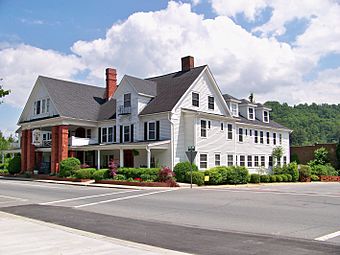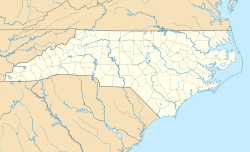Nu Wray Inn facts for kids
Quick facts for kids |
|
|
Nu-Wray Inn
|
|
 |
|
| Location | Off US 19E, Burnsville, North Carolina |
|---|---|
| Area | 0.7 acres (0.28 ha) |
| Built | 1833 |
| Architectural style | Colonial Revival |
| NRHP reference No. | 82003535 |
| Added to NRHP | April 15, 1982 |
The Nu Wray Inn is a very old and special hotel located in Burnsville, North Carolina. It's in Yancey County, North Carolina, a beautiful mountain area. This inn has been around for a long time, welcoming guests since 1833. It's so important that it's listed on the National Register of Historic Places. This means it's recognized as a place with great historical value.
Contents
A Historic Stay at the Nu-Wray Inn
The Nu Wray Inn was built in 1833. This was the same year that Yancey County, North Carolina was officially created. Burnsville, the town where the inn stands, was established just one year later.
When it was first built, the inn was made of logs. It had eight bedrooms for guests and a dining room with a kitchen. Over the years, it grew and changed, but it kept its charm. In 1982, it was added to the National Register of Historic Places. This honor helps protect its history for future generations.
Famous Visitors to the Inn
Many interesting people have stayed at the Nu Wray Inn over the years. In 1929, a famous writer named Thomas Wolfe spent a night there. He was in Burnsville to be a witness at a trial.
Other well-known guests include the legendary singer Elvis Presley. The famous short story writer William Sidney Porter, also known as O. Henry, also enjoyed a stay at this historic inn. Imagine all the stories these walls could tell!
A Family Legacy
For a whole century, the Nu Wray Inn was owned by the same family, the Wrays. It was a true family business, passed down through generations. This long family ownership ended after the death of Rush Wray, who was the head of the family.
A Special Place to Eat
In 1941, a journalist named Jonathan W. Daniels wrote about his experience at the Nu Wray Inn. He was very impressed by the food! He said that when you ate there, they brought out lots of different dishes. You didn't even need to order.
There were usually three or four kinds of meat and all sorts of fresh vegetables from the local farms. They also served homemade jellies and preserves. The country ham was especially good. He described it as a place with "country plenty," meaning there was always more than enough delicious, home-cooked food. It was a true taste of mountain hospitality.



